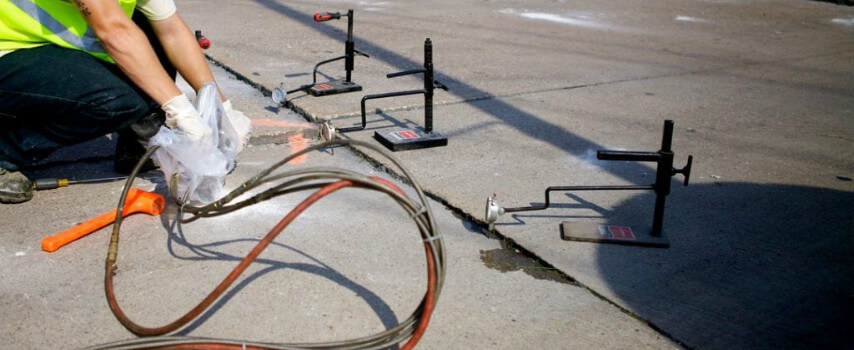What is the best foundation repair method?
When it comes to protecting your home, one of the most important aspects to consider is the foundation. A strong and stable foundation is the key to ensuring the longevity and structural integrity of your house. Over time, foundations can develop issues due to various factors such as soil movement, moisture, or poor construction. Thankfully, there are several foundation repair methods available that can help you restore the stability and strength of your home. In this article, we will discuss some of the best foundation repair methods you can consider.
Method 1: Foundation Piering

Foundation piering is a commonly used technique to repair foundation settlement issues. It involves the use of steel piers or helical piers that are driven deep into the ground until they reach stable soil layers. These piers act as support for the foundation, preventing further settlement and providing additional stability.
The process of foundation piering starts by excavating the soil around the foundation. Then, the piers are driven into the ground using specialized equipment. Once the piers reach the appropriate depth, hydraulic jacks are used to lift the foundation back to its original position. Finally, the piers are permanently secured to the foundation, ensuring long-lasting stability.
Method 2: Slabjacking

Slabjacking, also known as mudjacking, is a technique primarily used to repair sunken concrete slabs such as driveways, sidewalks, or basement floors. This method involves injecting a grout mixture beneath the sunken slab, which then lifts the concrete back to its original position.
The process of slabjacking begins by drilling small holes into the sunken concrete. A specialized grout mixture is then pumped under the slab through these holes, filling the voids and raising the concrete. Once the slab is lifted, the holes are patched, leaving a restored and level surface.
Method 3: Foundation Waterproofing
Foundation waterproofing is a vital step in preventing water damage and moisture-related issues in your home. Poor waterproofing can lead to basement leaks, mold growth, and even foundation damage. There are several methods to waterproof your foundation, including exterior waterproofing, interior waterproofing, and the use of protective coatings.
Exterior waterproofing involves excavating the soil around the foundation and applying a waterproof membrane or coating to the exterior walls. This helps to create a barrier against water penetration. Additionally, installing drainage systems such as French drains or gutters can help redirect water away from the foundation.
Interior waterproofing, on the other hand, involves addressing water issues from inside the basement. This can include the installation of sump pumps, interior drainage systems, and applying waterproof coatings to the interior walls. These measures help to collect and remove any water that seeps into the basement, keeping it dry and protected.
Method 4: Foundation Stabilization with Carbon Fiber Straps

Carbon fiber straps are an innovative solution used for stabilizing foundation walls that are experiencing bowing or cracking. This method involves the application of high-strength carbon fiber straps to the affected areas of the foundation, providing reinforcement and preventing further movement.
The process of installing carbon fiber straps starts by preparing the foundation walls. The walls are cleaned and prepped for the application of the carbon fiber material. Then, an epoxy adhesive is applied to the wall, and the carbon fiber straps are pressed into place. Once the adhesive cures, the carbon fiber becomes rigid and adds strength to the wall, effectively stabilizing it.
Method 5: Foundation Underpinning
Foundation underpinning is a technique used to strengthen and stabilize foundations that have experienced settling or structural damage. This method involves extending the depth or breadth of the foundation to reach more stable soil layers and provide additional support.
There are several types of foundation underpinning methods, including traditional underpinning, mini piles, and helical piers. These methods involve excavating the soil around the foundation and constructing a new support system or extending the existing foundation to reach load-bearing soil.
Method 6: Crawl Space Encapsulation

Crawl space encapsulation is a technique used to protect your home from moisture issues and improve indoor air quality. Many foundations have crawl spaces beneath them, which can become damp and prone to mold growth. Encapsulation involves sealing off the crawl space, installing a vapor barrier, and controlling humidity levels.
The process of crawl space encapsulation starts by removing any debris or moisture sources from the crawl space. Then, a heavy-duty vapor barrier is installed, covering the entire floor and walls of the crawl space. Additionally, insulation and dehumidifiers can be installed to regulate temperature and humidity, preventing mold growth and improving energy efficiency.
In conclusion, the foundation of your home is a crucial component that requires attention and maintenance. If you notice any signs of foundation damage such as cracks, sinking, or moisture issues, it is important to address them promptly. Consulting with a professional foundation repair contractor can help you determine the best method for repairing and protecting your home's foundation. Whether it's foundation piering, slabjacking, or any other method discussed in this article, taking action sooner rather than later will save you from costly repairs and potential hazards in the future.